Shankar IAS Summary: Plant Diversity of India- 2 | Famous Books for UPSC Exam (Summary & Tests) PDF Download
| Table of contents |

|
| Plant Classification |

|
| Effects of Abiotic Components on Plants |

|
| Insectivorous Plants |

|
| Invasive Alien Species |

|
| Invasive Alien Flora of India |

|
| Medicinal Plants |

|
| Tree Characters |

|
Plant Classification
- Herb:
- Definition: A plant with a stem that is always green and tender, typically not exceeding a height of 1 meter.
- Characteristics: Herbaceous plants are known for their non-woody, green, and soft stems.
- Shrub:
- Definition: A woody perennial plant that differs from a perennial herb in its persistence and woody stem. It distinguishes itself from a tree by its lower height, typically not exceeding 6 meters, and its habit of branching from the base.
- Characteristics: Shrubbery is characterized by its multiple stems and a comparatively shorter height than trees.
- Tree:
- Definition: A large woody perennial plant with a single well-defined stem and a more definite crown.
- Characteristics: Trees are known for their tall stature, well-defined trunk, and typically higher longevity compared to shrubs and herbs.
- Parasites:
- Definition: Organisms that draw part or all of their nourishment from another living organism, called a host.
- Total Parasite: Obtains the entirety of its nourishment from the host.
- Partial Parasite: Obtains only a portion of its nourishment from the host.
- Epiphytes:
- Definition: Plants that grow on a host plant but do not derive nourishment from it. Instead, they use the host for support and access to light.
- Characteristics: Epiphytes have roots that serve two functions—changing roots for anchoring to the host and aerial roots for extracting moisture from the air.
- Climbers:
- Definition: Herbaceous or woody plants that climb up trees or other supports using various mechanisms such as twining, tendrils, hooks, aerial roots, or other attachments.
- Characteristics: Climbers exhibit adaptive structures that allow them to ascend and gain access to sunlight by utilizing surrounding support structures.
 Amazon Rainforest
Amazon Rainforest
Do you know?
Kannimara teak is one of the largest living teak tree in the world. It has an amazing girth of and a crown height of is believed to be around 400 years old.
According to the local tribal belief here when this tree was tried to cut down, the blood spurted out from the place of cut. This tree was being since then worshipped by the local tribes in Parambikulam as "Virgin tree". Kannimara - ' Kanni' means 'Virgin'. This tree has been awarded 'Mahavriksha Puraskar' by the Government of India.
Effects of Abiotic Components on Plants
Intensity of Light on Plant Growth
High Intensity:
- Effects: High light intensity favors the development of the plant's root system over its shoot system. This results in a greater allocation of resources to root growth, leading to a short stem, increased transpiration, and the production of smaller, thicker leaves.
Low Intensity:
- Effects: On the contrary, low light intensity impedes the overall growth of the plant. It slows down processes such as flowering and fruiting, and if the intensity falls below a critical minimum, the plant may cease to grow due to the accumulation of carbon dioxide. Ultimately, this can lead to the death of the plant.
Visible Spectrum Colors:
Red and Blue Light: In the visible spectrum, red and blue light are crucial for photosynthesis. Plants absorb these colours most efficiently, and exposure to these wavelengths influences their growth and development. Blue light tends to result in smaller plants, while red light induces elongation of cells, causing plants to appear etiolated.
Ultraviolet and Violet Light: Plants grown in ultraviolet and violet light may exhibit dwarfism, indicating that these wavelengths are not as effective for promoting normal growth
Do you know?
- No tree dies of old age. They are generally killed by insects, disease or by people.
- Trees grow from the lop, not from the bottom as is commonly believed.
- Tree leaves help trap and remove tiny particles of soot and dust which otherwise damages human lungs
- Tree root networks filter contaminants in soils producing clean water.
- Trees prevent erosion by trapping soil that would otherwise become silt
Effect of Frost on Plants
Killing of Young Plants:
- Causes: Frost can have lethal effects on young plants. Even a light frost can chill the soil, leading to the freezing of soil moisture. When these plants are subsequently exposed to direct sunlight, their increased transpiration rates, coupled with inadequate root moisture supply, can result in their death.
Damage to Cells:
- Effects: Frost causes the freezing of water in the intercellular spaces of plants, leading to the withdrawal of water from the cell interiors. This results in an increased concentration of salts, dehydration of cells, and the coagulation and precipitation of cell colloids, ultimately causing the death of the plant.
Formation of Canker:
- Role of Snow: In some cases, snow acts as a protective blanket, preventing further drops in temperature and shielding seedlings from excessive cold and frost. This can mitigate the damaging effects of frost on plant tissues.
Mechanical Bending of Tree Stem:
- Outcome: Frost can lead to the mechanical bending of tree stems. This bending not only shortens the period of vegetative growth but may also uproot trees, particularly those with weaker structures.
 Frost on Plant
Frost on Plant
Effect of Temperature on Plants
- Excessive High Temperature:
Consequences: Excessive high temperatures can lead to plant death. The coagulation of protoplasmic proteins disrupts the delicate balance between respiration and photosynthesis. This imbalance results in the depletion of food reserves, making plants more susceptible to fungal and bacterial attacks.
Additional Effects: The high temperature can also cause desiccation of plant tissues and lead to the depletion of moisture, further stressing the plant.
Die Back
Definition: Dieback is a phenomenon where a portion of a plant, usually starting from the tip, progressively dies backwards.
Adaptive Mechanism: Dieback is considered an adaptive mechanism employed by some plants to cope with adverse conditions. In this mechanism, the plant allocates resources to keep its root system alive for an extended period while allowing the above-ground portions (shoots) to die off.
Causes for Die Back:
- Dense Overhead Canopy and Inadequate Light: Lack of sufficient light penetration due to a dense overhead canopy can trigger dieback.
- Dense Weak Growth: Plants with weak and dense growth patterns may experience die back.
- Undecomposed Leaf Litter on Surface: Accumulation of undecomposed leaf litter can create conditions conducive to die back.
- Frost: Cold temperatures, especially frost, can contribute to die back.
- Drought: Prolonged periods of water scarcity can trigger die back.
- Drip: Drip, or the slow release of water, can contribute to die back if not properly managed.
Examples: Some examples of plants exhibiting die back include Sal, Red Sanders, Terminalia tomentosa, Silk Cotton Tree, and Boswellia serrata.
Insectivorous Plants
Differentiation from Normal Plants:
Insectivorous plants have evolved unique adaptations for obtaining nutrients. While normal plants rely on the soil for nutrients, insectivorous plants supplement their nutrient requirements by trapping and digesting insects. This strategy is particularly beneficial in nutrient-poor environments.Active and Passive Types:
Active Traps: Plants like Venus flytrap (Dionaea) fall into this category. They possess specialized mechanisms that allow them to actively close their leaf traps when triggered by the presence of insects.
Passive Mechanism: Examples include pitcher plants (Nepenthes) and sundews (Drosera). These plants have structures resembling jars or pitchers, where insects fall in and are later digested. This mechanism is passive in the sense that the plant doesn't actively close a trap around the insect.Attractions to Lure Prey:
Insectivorous plants employ various strategies to attract and capture insects. These include brilliant colors, sweet secretions, and other enticing features that make them visually appealing to potential prey.Hunting in Nutrient-Poor Soils:
Insectivorous plants are often found in habitats with rain-washed, nutrient-poor soils or wet and acidic areas that are ill-drained. These environments are challenging for normal plants to thrive due to a lack of essential nutrients.
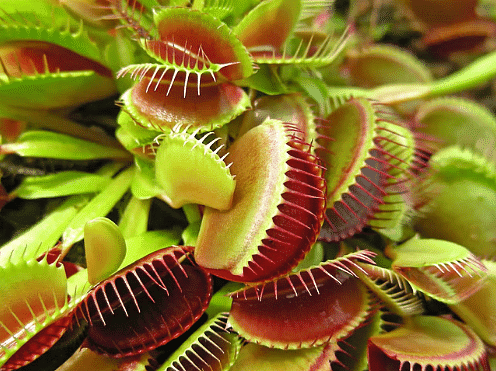 Insectivorous Plant
Insectivorous Plant
Why do They Hunt Despite Normal Roots and Photosynthetic Leaves?
In nutrient-poor habitats, normal plants struggle to meet their nutritional needs. Insectivorous plants, by capturing and digesting insects, supplement their nutrient intake. This adaptation allows them to thrive in environments where traditional methods of nutrient acquisition may not be sufficient.
Insectivorous Plants of India
Drosera or Sundew
- Habitat: These plants are commonly found in wet infertile soils or marshy places.
- Insect Trapping Mechanism: The leaves of Drosera secrete a sticky fluid that resembles dewdrops. Insects lured by these glistening drops get stuck in the fluid and are subsequently absorbed and digested.
Aldrovanda
- Habitat: Aldrovanda is a unique, rootless aquatic plant found in salt marshes and freshwater bodies like ponds and lakes.
- Insect Trapping Mechanism: The plant uses sensitive trigger hairs on its leaf midrib. When an insect contacts these trigger hairs, the leaf halves close, trapping the insect inside.
Nepenthes (Pitcher Plants)
- Distribution: Found in the high rainfall hills and plateaus of the northeastern region in India.
- Insect Trapping Mechanism: Nepenthes employs a pitfall-type trap with a jar-like structure. A honey-like substance is secreted, attracting insects. Once inside the pitcher, insects fall due to slipperiness, and digestive enzymes break down their bodies for nutrient absorption.
Utricularia or Bladderworts
- Habitat: Typically inhabits freshwater wetlands, waterlogged areas, and moss-covered rock surfaces during rains.
- Insect Trapping Mechanism: Bladderworts have bladders with sensitive bristles. When an insect contacts these bristles, the bladder's door opens, allowing the insect to be carried inside by a current of water. Enzymes within the bladder then digest the insect.
Pinguicula or Butterwort
- Habitat: Thrives in the alpine heights of the Himalayas, particularly from Kashmir to Sikkim, along stream-sides in cool, boggy places.
- Insect Trapping Mechanism: The entire leaf of Pinguicula acts as a trap. When an insect lands on the leaf surface, it gets stuck in the sticky exudate, and the leaf margins roll up, trapping the victim.
Medicinal Properties
Drosera
- Capable of curdling milk.
- Bruised leaves applied on blisters.
- Used for dyeing silk.
Nepenthes:
- Used in local medicine to treat cholera patients.
- The liquid inside the pitcher is useful for urinary troubles.
- Used as eye drops.
Utricularia:
- Useful against cough.
- Used for dressing wounds.
- Remedial use for urinary diseases.
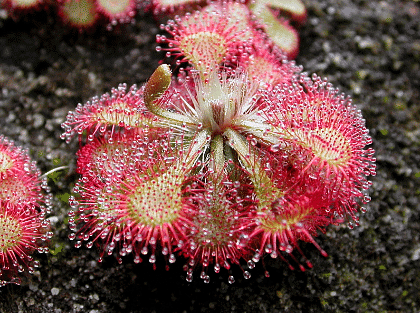 Drosera
Drosera
Threats to Insectivorous Plants
Gardening Trade and Medicinal Properties
The decline of these plants is fueled by their exploitation in the gardening trade and the demand for their perceived medicinal properties. This often leads to overharvesting.Habitat Destruction:
The expansion of urban and rural areas often destroys wetlands, which are crucial habitats for insectivorous plants. This habitat loss is a significant threat to their survival.Pollution:
Effluents containing detergents, fertilizers, pesticides, sewage, etc., pollute wetlands. Since insectivorous plants are adapted to nutrient-poor conditions, they cannot tolerate high nutrient levels. This pollution contributes to their decline.Overall Threat:
The combination of trade exploitation, habitat destruction, and pollution severely threatens the existence of insectivorous plants. The delicate balance of these unique species is at risk, affecting biodiversity and ecological health. Conservation efforts are crucial to mitigate these threats and protect these fascinating plants.
Invasive Alien Species
Introduction of Non-Native Species
People, either intentionally or unintentionally, often introduce non-native species into new areas where these species lack natural predators to control their populations.Definition of Alien Species:
Alien species refer to those occurring outside their natural range. When these alien species pose a threat to native plants, animals, or biodiversity, they are termed "alien invasive species."Wide Range of Invasion:
Alien invasive species can be found across various groups of plants and animals, acting as competitors, predators, pathogens, and parasites. They have invaded nearly every type of native ecosystem.Biological Invasion as a Major Threat:
Biological invasion by alien species is recognized as a major threat to native species and ecosystems. The impact on biodiversity can be enormous and often irreversible.
Invasion and Species Richness
Potential Increase in Species Richness
Invasions have the potential to increase species richness by adding invasive species to the existing species pool.Negative Interactions:
However, invasions can also lead to the extinction of native species, resulting in a decrease in species richness. Negative interactions primarily involve competition with natives for food and space, challenging coexistence and predation.
Effects
Loss of Biodiversity
One of the most significant consequences of biological invasion is the loss of biodiversity. The introduction of alien species can lead to the decline and extinction of native species, especially endemics.Habitat Loss:
The invasion process often results in habitat loss, disrupting the natural balance and functions of ecosystems.Impact on Agriculture:
Introduced pathogens can reduce crop and stock yields, affecting agricultural productivity.Degradation of Ecosystems:
Invasive species can contribute to the degradation of marine and freshwater ecosystems, impacting the health of these environments.Greatest Threat to Biodiversity:
Biological invasion is considered the greatest threat to biodiversity, with devastating consequences for the planet. Conservation managers face significant challenges in mitigating these impacts.
Invasive Fauna in India
New Invasive Insect of Eucalyptus
A new invasive gall-forming insect of Eucalyptus has been detected in southern India. Leplocybe invasa, a tiny wasp, forms leaf and stem galls in Eucalyptus. It was initially found in coastal Tamil Nadu and has since spread to peninsular India.Other Invasive Fauna in India
Apart from the gall-forming insect, there are other invasive fauna in India, including the Crazy ant, Giant African snail, Myna, Goldfish, Pigeon, Donkey, House Gecko, and Tilapia.Wide Range of Invasive Species
These invasive species pose a threat to local ecosystems and biodiversity. It is crucial to monitor and manage the spread of these invasive fauna to prevent further ecological disruptions.
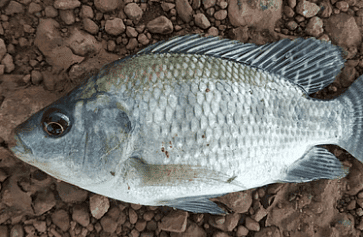 Tilapia
Tilapia
Invasive Alien Flora of India
- Needle Bush
Nativity: Trop. South America
Distribution in India: Throughout
Remarks: Occasional in thorny scrub and dry degraded forests and often creates close thickets. - Black Wattle
Nativity: South East Australia
Distribution in India: Western Ghats
Remarks: Introduced for afforestation in the Western Ghats. Regenerates rapidly after fire and forms dense thickets. Distributed in forests and grazing lands in high-altitude areas. - Goat Weed:
Nativity: Trop. America
Distribution in India: Throughout
Remarks: Aggressive colonizer. Troublesome weed in gardens, cultivated fields, and forests. Alternanthera paronychioides :
Nativity: Trop. America
Distribution in India: Throughout
Remarks: Occasional weed along edges of tanks, ditches, and in marshy lands.Prickly Poppy:
Nativity: Trop. Central & South America
Distribution in India: Throughout
Remarks: Aggressive colonizer. Common winter season weed in cultivated fields, scrub lands, and fringes of forests.Blumea eriantha:
Nativity: Trop. America
Distribution in India: Throughout
Remarks: Aggressive colonizer. Abundant along railway tracks, roadsides, and degraded forest lands.Palmyra, Toddy Palm:
Nativity: Trop. Africa
Distribution in India: Throughout
Remarks: Aggressive colonizer. Cultivated and self-sown, occasionally found to be gregarious near cultivated fields, scrub lands, and wastelands.Calotropis / Madar, Swallow Wort:
Nativity: Trop. Africa
Distribution in India: Throughout
Remarks: Aggressive colonizer. Common in cultivated fields, scrub lands, and waste lands.Datura, Mad Plant, Thorn Apple:
Nativity: Trop. America
Distribution in India: Throughout
Remarks: Aggressive colonizer. Occasional weed on disturbed ground.Water Hyacinth:
Nativity: Trop. America
Distribution in India: Throughout
Remarks: Aggressive colonizer. Abundant in still or slow floating waters. A nuisance for aquatic ecosystems.Impatiens, Balsam:
Nativity: Trop. America
Distribution in India: Throughout
Remarks: Aggressive colonizer. Common along streams of moist forests and occasionally along railway tracks; also runs wild in gardens- Ipomoea / Pink Morning Glory:
Nativity: Trop. America
Distribution in India: Throughout
Remarks: Aggressive colonizer. Common weed of marshy lands and along the edges of tanks and ditches. - Lantana camara / Lantana, Wild Sage:
Nativity: Trop. America
Distribution in India: Throughout
Remarks: Aggressive colonizer. A common weed of forests, plantations, habitation, wastelands, and scrub lands. - Black Mimosa:
Nativity: Trop. North America
Distribution in India: Himalayas, Western Ghats
Remarks: Aggressive colonizer. Invades water courses and seasonally flooded wetlands - Touch-Me-Not, Sleeping Grass:
Nativity: Brazil
Distribution in India: Throughout
Remarks: Aggressive colonizer. Common weed of cultivated fields, scrub lands, and degraded forests. - 4 O'Clock Plant:
Nativity: Peru
Distribution in India: Throughout
Remarks: Aggressive colonizer. Runs wild in gardens and near habitation - Parthenium / Congress Grass, Parthenium:
Nativity: Trop. North America
Distribution in India: Throughout
Remarks: Aggressive colonizer. A common weed of cultivated fields, forests, overgrazed pastures, wastelands, and gardens. - Prosopis juliflora / Mesquite:
Nativity: Mexico
Distribution in India: Throughout
Remarks: Aggressive colonizer. Common weed of waste lands, scrub lands, and degraded forests. - Townsend Grass:
Nativity: Trop, W. Asia
Distribution in India: Throughout
Remarks: Very common along streams and banks of rivers.
Do you know?
The world’s tallest tree is a coast redwood in California, measuring more than 360 ft
Medicinal Plants
Beddomes Cycad / Perita / Kondaitha
- Distribution: Found in Eastern Peninsular India.
- Uses:
- Local herbalists use the male cones of the plant as a remedy for rheumatoid arthritis and muscle pains.
- Notably, the plant possesses a fire-resistant property.
Blue Vanda / Autumn Ladies Tresses Orchid
- Distribution: Native to Assam, Arunachal Pradesh, Manipur, Meghalaya, Nagaland.
- Unique Feature:
- Vanda is distinctive among orchids for its rare blue flowers, making it highly valued for producing interspecific and intergeneric hybrids.
Kuth / Kustha / Pooshkarmoola / Uplet
- Distribution: Found in Kashmir and Himachal Pradesh.
- Uses:
- The plant is utilized as an anti-inflammatory drug and is a
- component of traditional Tibetan medicine.
- Its roots are employed in perfumery, producing a strongly scented oil used in making insecticides.
- The roots contain an alkaloid, 'Saussure,' which holds medicinal significance.
Ladies Slipper Orchid
- Uses:
- Primarily sought after as collector’s items.
- Occasionally used for treating anxiety/insomnia (with limited scientific evidence).
- Topically applied as a poultice or plaster for relief from muscular pain.
Red Vanda
- Distribution: Found in Manipur, Assam, Andhra Pradesh.
- Uses:
- Orchids, including the Red Vanda, are collected to meet the demands of the orchid fanciers' market, spanning Europe, North America, and Asia.
Sarpagandha (Rauvolfia serpentine)
- Distribution: Sub-Himalayan tract from Punjab eastwards to Nepal, Sikkim, Assam, Eastern & Western Ghats, parts of Central India, and in the Andamans.
- Uses:
- Medicinal Value: Rauvolfia roots are highly valued for medicinal purposes with a steady demand.
- Treatment of Central Nervous System Disorders: Used for treating various central nervous system disorders.
- Active Alkaloids: Contains several alkaloids, with reserpine being the most important. Reserpine is utilized for its sedative action in mild anxiety states and chronic psychoses.
- Pharmacological Actions: Exhibits depressant action on the central nervous system, leading to sedation and lower blood pressure.
- Treatment of Intestinal Disorders: Root extracts are used for treating intestinal disorders, particularly diarrhoea and dysentery. It also serves as an anthelmintic.
- Additional Uses: Used for the treatment of cholera, colic, fever, and corneal opacity. Juice from the leaves is applied as a remedy.
- Total Root Extracts: Demonstrates various effects, including sedation, hypertension, bradycardia, myosis, ptosis, and tremors, typical of reserpine.
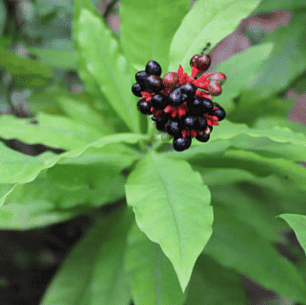 Sarpagandha
Sarpagandha
Ceropegia Species
- Common Names: Lantern Flower, Parasol Flower, Parachute Flower, Bushman's Pipe
- Uses: Primarily used as ornamental plants.
Emadi / Indian Podophyllum
- Common Names: Himalayan May Apple, India May Apple, etc.
- Distribution: Found in lower elevations in and around the Himalayas.
- Uses:
- Constituent Drug: Rhizomes and roots constitute the drug.
- Medicinal Resin: Dried rhizomes are the source of medicinal resin, with podophyllin being toxic and strongly irritant to the skin and mucous membranes.
Tree Ferns
- Distribution: Lower elevations in and surrounding the Himalayas.
- Uses:
- Edible Source: The Soft Tree Fern can be used as a food source. The pith of the plant is eaten, either cooked or raw, and is a good source of starch.
Cycads
- Characteristics:
- Gymnosperm trees are known as living fossils.
- Distribution: Found in the Western Ghats, Eastern Ghats, North East India, and Andaman and Nicobar Islands.
- Uses:
- Historical Uses: Used as a source of starch and in socio-cultural rituals.
- Threats:
- Environmental Threats: Face threats from overharvesting, deforestation, and forest fires.
- Health Concerns: Regular consumption of starch derived from cycads is indicated as a potential factor in the development of Lytico-Bodig disease, a neurological disease with symptoms similar to Parkinson’s disease and ALS.
Elephant’s Foot
- Distribution: Throughout the North Western Himalayas.
- Uses:
- Commercial Significance: Serves as a commercial source of Diosgenin, a steroid sapogenin. Diosgenin is used for the synthesis of various steroid products, including cortisone, pregnenolone, and progesterone.
Do you know?
The world’s oldest trees are 4,600-year-old Bristle - cone pines in the U.S.A.
Tree Characters
Types of Trees
Deciduous Trees
Description:- Shed all their leaves for part of the year.
- In cold climates, leaf shedding occurs during autumn, leaving trees bare throughout winter.
- In hot and dry climates, deciduous trees lose leaves during the dry season.
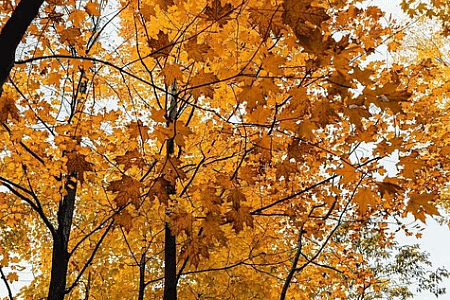 Deciduous Tree
Deciduous Tree
- Evergreen Trees
Description:- Retain leaves throughout the year, ensuring constant foliage.
- Shed old leaves gradually while new ones grow in to replace them.
- Always maintain some level of leaf cover.
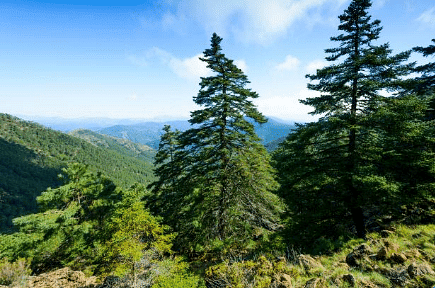 Evergreen Trees
Evergreen Trees
Parts of a Tree
Roots
Function:- Grow underground to prevent the tree from tipping over.
- Collect water and nutrients from the soil, storing them for times of scarcity.
- Crown
Components:
Comprises leaves and branches at the top of the tree.
Functions- Shades the roots.
- Collects energy from the sun through photosynthesis.
- Facilitates transpiration, similar to sweating in animals.
- Leaves
- Function:
- Convert energy into food (sugar) through photosynthesis.
- Serve as the food factories of a tree.
- Contains chlorophyll, giving leaves their green color.
- Function:
- Branches
- Role:
- Provide support for efficient leaf distribution.
- Act as conduits for water and nutrients.
- Serve as storage for extra sugar.
- Role:
- Trunk
- Functions:
- Shapes and supports the tree.
- Transports water, nutrients, and sugar between roots and leaves.
- Functions:
Parts of the Trunk
Annual Rings
- Purpose:
- Indicate the age of the tree.
- Used in Dendro-Chronology and Paleo-Climatology.
- Growth is influenced by environmental conditions.
- Purpose:
- Bark
- Composition:
- Outer and inner layers.
- Functions:
- Protects the tree.
- The inner bark (Phloem) transports sap full of sugar.
- Composition:
- Cambium
- Description:
- Thin layer of living cells just inside the bark.
- Function:
- Produces new cells, allowing the tree to grow wider each year.
- Description:
Sapwood (Xylem)
- Function:
- Network of living cells transporting water and nutrients from roots to leaves.
- Youngest wood that eventually becomes heartwood.
- Function:
Heartwood
- Characteristics:
- Dead sapwood in the center of the trunk.
- Provides support and strength.
- Usually darker than sapwood.
- Characteristics:
Pith
- Description:
- Tiny, spongy living cells in the center of the trunk.
- Function:
- Carries essential nutrients upward.
- Protected from damage due to its central position.
- Description:
Root Types
- Taproot - Primary descending root formed by the direct prolongation of the radicle of the embryo.
- Lateral Root - Roots that arise from the tap root and spread laterally to support the tree.
- Adventitious Roots - Roots that are produced from the parts of the plant other than the radicle or its subdivision.
Ex: Silk cotton tree
Ex. Banyan Tree
Ex: Rhizphora species of mangroves.
Ex: Heretiera spp, Bruguiera spp.
Eg: mistletoe (Viscum alubum) and dodder.
Do you know?
- A tree can absorb as much as 48 pounds of carbon dioxide per year and can sequester 1 ton of carbon dioxide by the time it reaches 40 years old,
- Treewood is a highly organized arrangement of living, dying, and dead cells.
Canopy Classification
- Closed - the density is 1.0
- Dense - the density is 0.75 to 1.0
- Thin - the density is 0.50 to 0.75
- Open - the density is under 0.50
Other Characters
- Phenology
- Deals with the timing of characteristic periodic events.
- Etiolation
- The pale yellowing of plants due to insufficient light.
- Autumn Tints
- Striking color change in some trees before leaf shedding.
- Ex: Mango, Cassia fistula, Quercus incana
- Taper
- Decrease in stem diameter from base upwards, reinforcing against wind pressure.
- Bamboo Gregarious Flowering:
- General flowering over a considerable area, followed by plant death.
- Sal Tree Geological Variability:
- Grows in various geological formations but absent in Deccan trap, replaced by teak.
- Sandal Tree Partial-Root Parasitism:
- Partial parasite with haustorial connections to nearby shrubs and trees for water and nutrients.
- Aerial Seeding:
- Dispersal of seeds aerially, experimented in Chambal ravines in India.
- Survival percentages observed for different tree species.
|
1179 videos|2219 docs|849 tests
|
FAQs on Shankar IAS Summary: Plant Diversity of India- 2 - Famous Books for UPSC Exam (Summary & Tests)
| 1. What is plant classification and why is it important? |  |
| 2. How do abiotic components affect plants? |  |
| 3. What are invasive alien species and why are they a concern? |  |
| 4. What are insectivorous plants and how do they obtain nutrients? |  |
| 5. What are medicinal plants and how are they used in traditional medicine? |  |















